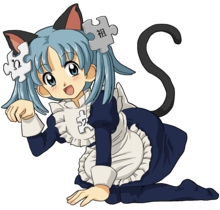Catgirl
- This article deals with the Catgirl in popular culture. For information of historical interest on the mythical creature, see Bakeneko.
- See Carrie Kelly for the sidekick Catgirl in Batman: The Dark Knight Strikes Again. For a similarly named superhero, see Catwoman.

A catgirl is a female with cat ears, a cat tail, or other feline characteristics on an otherwise human body. Catgirls are found occasionally in anime and manga either as a form of cosplay or actual body parts, as well as in a few video games. Catgirls may wear over-sized mittens and shoes that look like paws. In Japan, catgirls are usually called nekomimi (猫耳) — literally, "cat ears" — rather than the literal term nekomusume (猫娘). Sometimes characters do not actually feature cat-like ears or such an accessory but their hair sticks out and resembles cat ears. Such characters do not fit the definition of catgirls. Other animal combinations, usually mammals like bunnygirls, foxgirls and (more rarely) doggirls, are referred to as kemonomimi.
Eastern catgirls are usually depicted as having minimal feline characteristics, such as eyes with vertical pupils, tails, and ears (often with different color ear-fur than their hair). Western catgirls are more often portrayed as more animal-like in appearance, with full body fur and claws being their most prominent aspects, though not true for all cases.
Personality traits

Ordinary human characters will sometimes sprout cat ears or a tail in order to illustrate their excitable personalities. This is similar to the phenomenon of becoming super deformed and is mostly a stylistic quirk from manga.
Characters in anime and manga may momentarily develop a catlike mouth. This is usually used to emphasize mischievous thoughts or comments by a character. Rebellious boys are more often compared to dogs or wolves. The "lone-wolf" characterization is very common for brooding, aggressive, socially isolated males, while comparisons to dogs usually refer to adorably rebellious but ultimately harmless boys.
In certain anime and manga series, a boy may be compared to a cat in a similar way catgirls are. They are referred to as catboys. Bishōnen catboys are typically associated with shōjo manga and yaoi.
In shōnen series, a (usually villainous) catgirl may be portrayed as the leader of a band of anthropomorphic animals.
Western
Catgirl characters are also found outside of anime, manga, and video games. Often, such catgirls are more like humanoid cats than their Japanese counterparts, for example Cheetara from ThunderCats. Fantasy games have catgirl characters, such as Magic: The Gathering's Mirri and Purraj and the cat girl monster in the d20 Munchkin Monster Manual. Some live-action shows and movies (Teenage Catgirls in Heat), as well as Western comics and animation, have featured various cat-like characters. In addition, catgirls make occasional appearances in Western science-fiction, like Cordwainer Smith's cat-derived Underperson C'Mell (who appears in Norstrilia and The Rediscovery of Man).
However, catgirls that adhere strictly to the catgirl stereotype are far outnumbered in Western culture by those that are better defined as werecats, because they are shapeshifters who only sometimes have a cat-humanoid appearance, analogous to werewolves and other lycanthropes. Like Asian catgirls, these creatures are portrayed as predominantly female and often have the stereotypical catgirl personality and habits. They tend to appear in more realistic settings in the fantasy or horror genres, not in the anime world of typical catgirls.
See also
External links
- The Catgirl Research Foundation Catgirl info center - art, fiction reference, science, mythology, discussion forum, links database.
